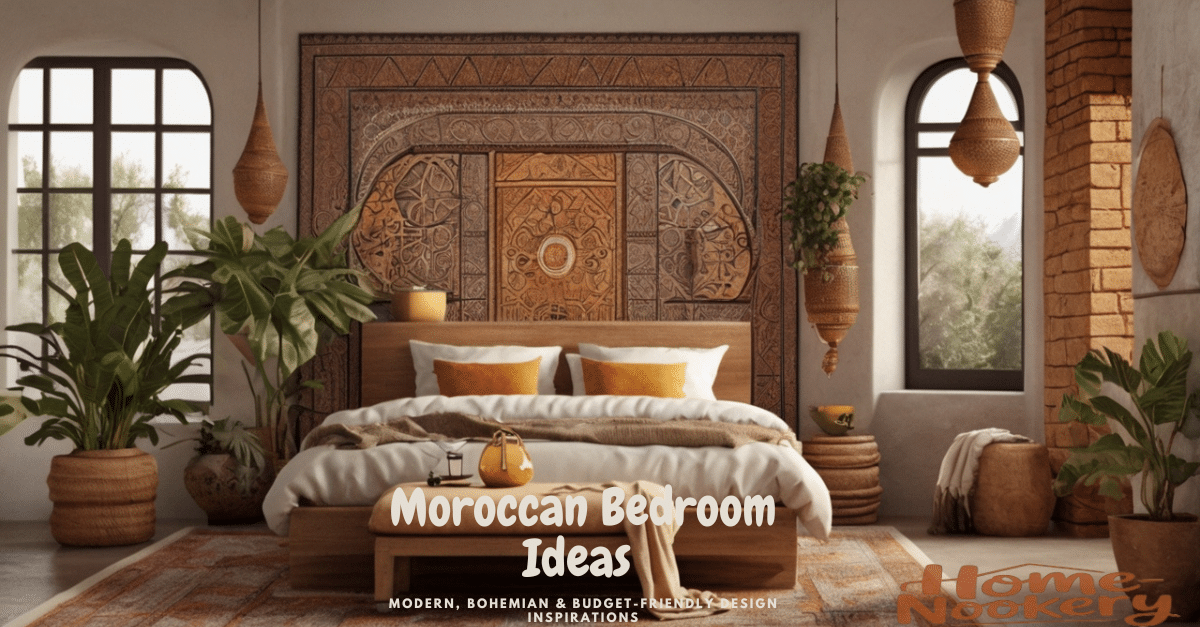Stepping into a Moroccan-inspired bedroom feels like being transported to an exotic oasis where vibrant colors, intricate patterns, and luxurious textures create a sanctuary of comfort and style. The allure of Moroccan design has captivated interior enthusiasts worldwide, and in 2025, this aesthetic continues to evolve with contemporary twists that honor tradition while embracing modernity.
I’ve been obsessed with Moroccan design elements for over a decade. Trust me when I say that incorporating these elements into your bedroom doesn’t mean you gotta completely overhaul your space or break the bank. The beauty of Moroccan design lies in its versatility and adaptability to various tastes, spaces, and budgets.
In this article, I’ll guide you through 15 stunning Moroccan bedroom ideas that blend traditional North African elements with modern sensibilities, bohemian flair, and budget-conscious approaches. Whether you’re dreaming of a full-on Moroccan retreat or just want to add subtle touches to your existing decor, these inspirations will help transform your bedroom into a personal haven that’s both trendy and timeless.
1. Jewel-Toned Color Palette
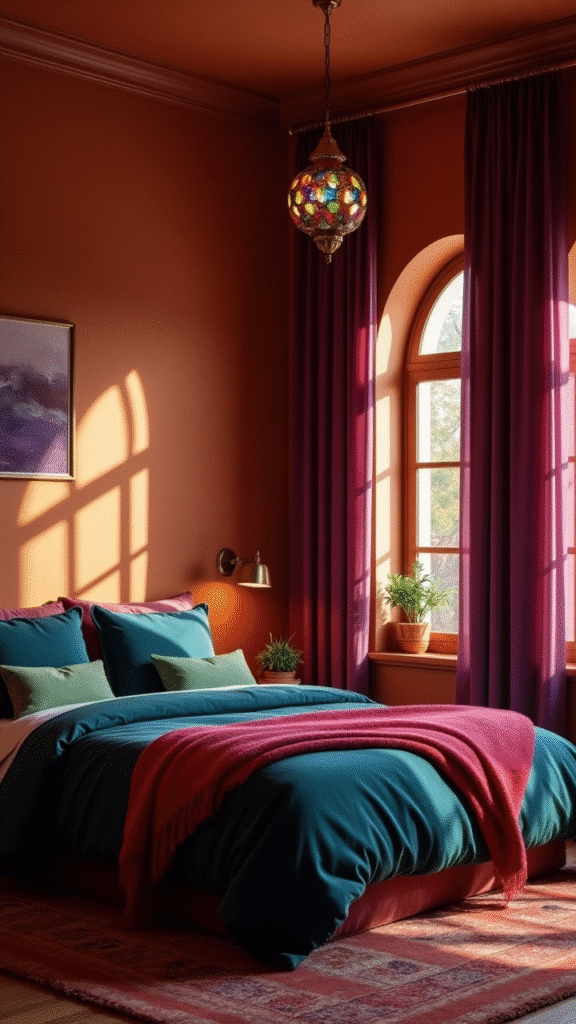
The foundation of any authentic Moroccan bedroom begins with a rich, jewel-toned color palette. Think deep sapphire blues, emerald greens, ruby reds, and amethyst purples. These colors evoke the vibrant marketplaces and stunning tilework found throughout Morocco.
For 2025, designers are pairing these traditional hues with softer neutrals like warm terracotta, sandy beige, and muted gold to create balance. This combination prevents the space from feeling overwhelming while maintaining that distinctive Moroccan energy. Consider painting an accent wall in a bold jewel tone or keeping walls neutral and introducing color through textiles and accessories.
The key is layering these colors thoughtfully – perhaps a deep blue duvet against terracotta walls, accented with emerald and gold pillows. Remember, you don’t need to use ALL the colors at once; even just two complementary jewel tones against a neutral backdrop can create that Moroccan magic without going overboard.
2. Ornate Metalwork: Lanterns & Pendants
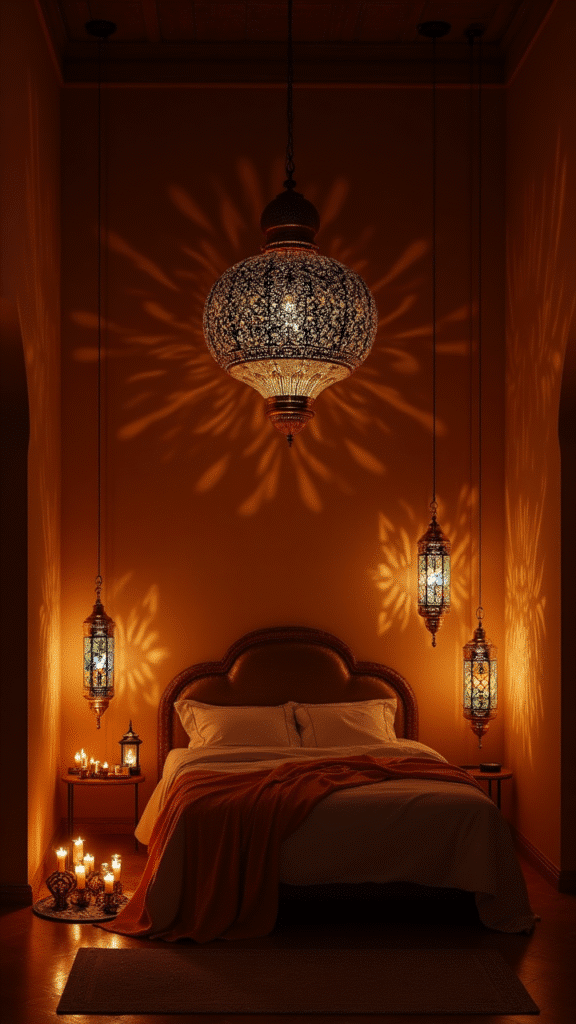
Nothing says “Moroccan design” quite like the distinctive perforated metalwork that creates mesmerizing light patterns across walls and ceilings. Moroccan lanterns and pendant lights aren’t just illumination sources – they’re dramatic works of art that transform your space day and night.
In 2025, we’re seeing a trend toward oversized statement pieces – massive copper or brass pendants suspended above beds or in corners. These create incredible shadow play when lit and serve as sculptural elements even when turned off. For smaller spaces or tighter budgets, cluster several smaller lanterns at varying heights to create a similar effect.
The coolest part about these fixtures is the ambient lighting they create – soft, diffused, and almost magical. The intricate cutout patterns cast shadows that dance across your walls, turning a simple bedroom into something from Arabian Nights. Look for pieces with colored glass inserts for an extra layer of visual interest when illuminated.
3. Low-Profile Seating & Floor Cushions
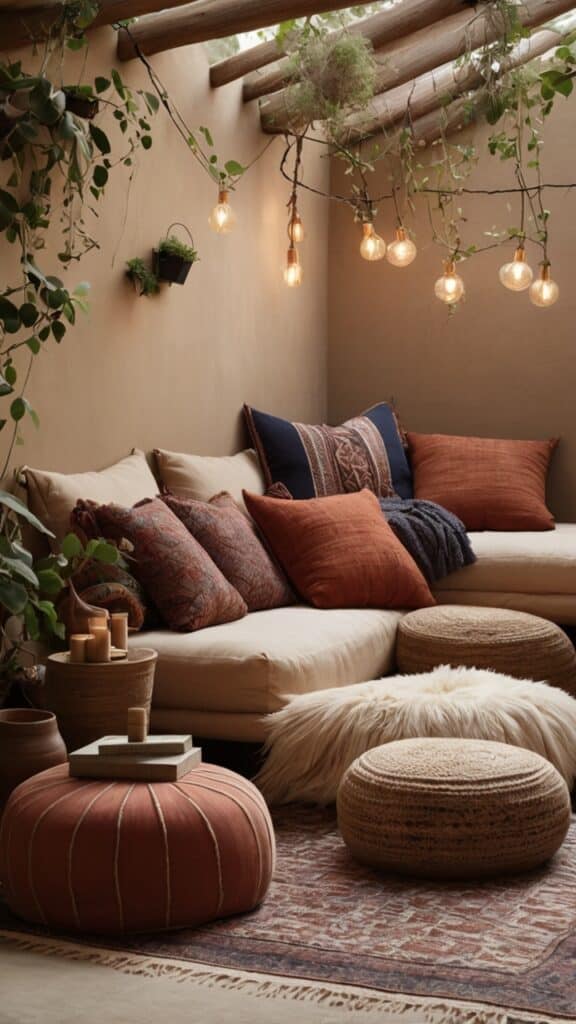
Traditional Moroccan bedrooms embrace a more grounded lifestyle with low-profile furniture and plenty of floor cushions for lounging. This approach creates a relaxed, informal atmosphere that encourages comfort and conversation.
For a modern take in 2025, consider creating a meditation corner or reading nook with oversized floor pillows in mix-matched patterns and textures. Poufs are particularly versitile pieces that can serve as footrests, impromptu seating, or even side tables when topped with a tray. Choose ones covered in leather with intricate embroidery or colorful fabric with geometric patterns.
This low-height approach to seating makes spaces feel larger and more open, perfect for smaller bedrooms. It also creates a sense of casual luxury that’s become increasingly popular as people seek more laid-back, multifunctional spaces in their homes. Plus, floor cushions are easy to rearrange or store away when you need more floor space!
4. Statement Headboards & Carved Wood
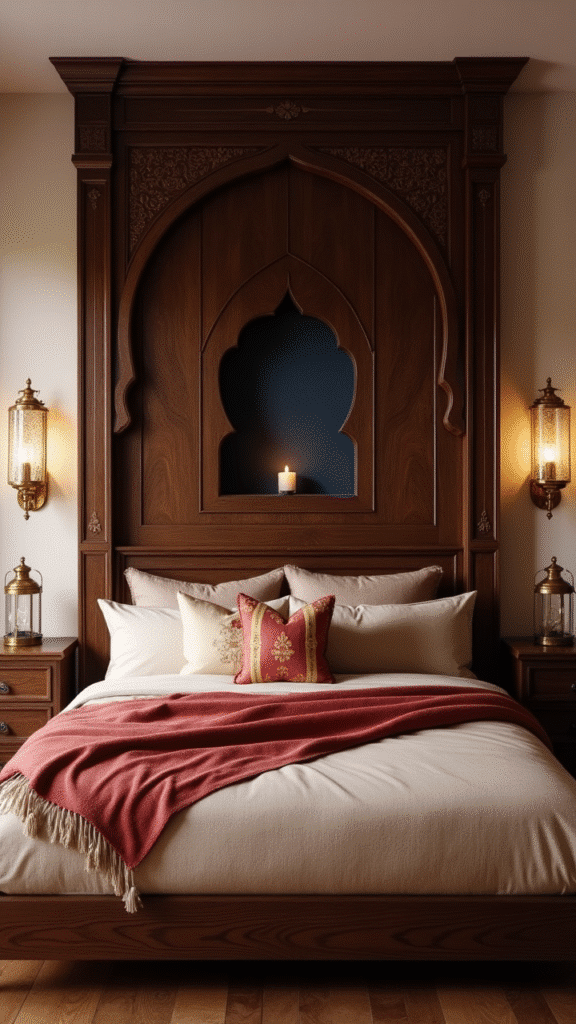
A Moroccan-inspired bedroom deserves a headboard that commands attention. Traditional carved wooden headboards featuring geometric patterns or arched silhouettes are hallmarks of authentic Moroccan design.
For 2025, we’re seeing incredible innovations in this space – from fully carved solid wood pieces to creative alternatives like painted motifs, fabric-covered panels with nail-head trim in geometric patterns, or even wall decals that mimic intricate carving work. Some homeowners are even repurposing antique Moroccan doors or architectural salvage as one-of-a-kind headboards.
If your budget doesn’t stretch to custom carpentry, consider mounting a large tapestry, rug, or even a painted wooden room divider behind your bed. The goal is to create that sense of grand architecture and craftsmanship that’s so central to Moroccan interiors. I’ve seen someone use an inexpensive lattice garden panel, painted it gold, and mounted it behind their bed – it looked amazin and cost under $100!
5. Layered Textiles & Berber Rugs
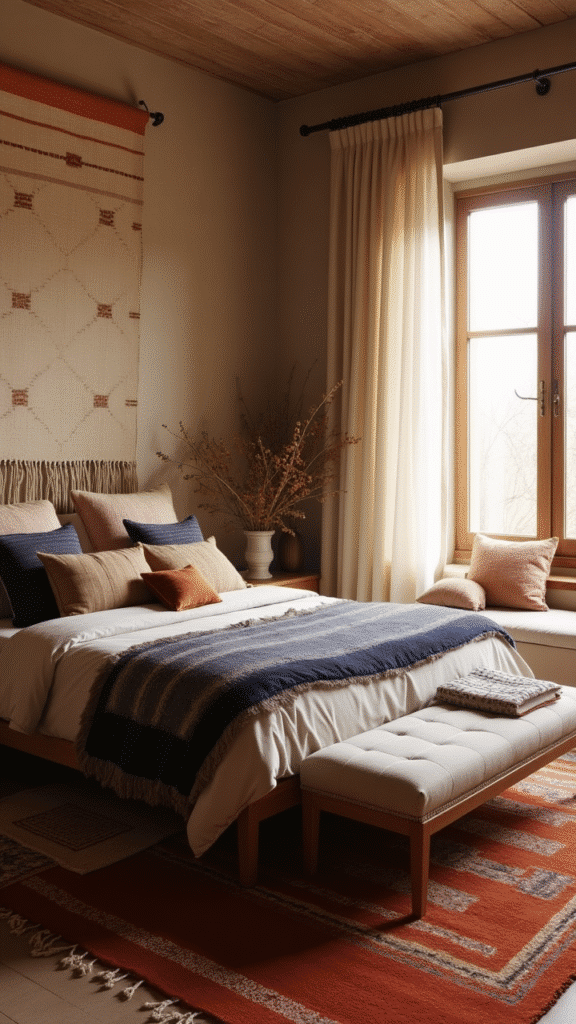

Moroccan design embraces textile layering to create depth, warmth, and visual interest. In authentic Moroccan homes, you’ll find multiple rugs overlapping, blankets draped across furniture, and an abundance of pillows in various sizes and shapes.
The star of any Moroccan-inspired bedroom is undoubtedly the Berber rug – characterized by distinctive geometric patterns, usually in neutral colors with pops of color or metallic threads. In 2025, designers are playing with scale, using oversized patterns or placing smaller rugs at unexpected angles. Some are even mounting these textiles on walls as art pieces!
Don’t stop at the floor though. Layer your bed with a mix of textures – perhaps a lightweight cotton blanket beneath a silk throw, topped with velvet and embroidered pillows. The trick is mixing patterns that share color elements while varying their scale – perhaps a large geometric print paired with smaller florals or zigzags. It seems chaotic on paper, but when executed thoughtfully, it creates that effortless, collected-over-time look that defines Moroccan spaces.
6. Arched Alcoves & Architectural Details
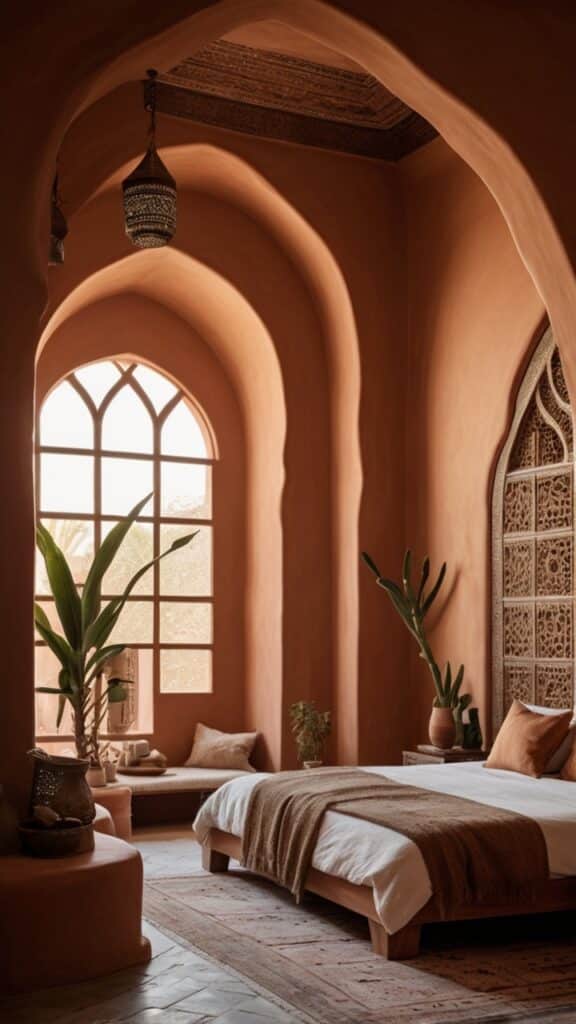
Moroccan architecture is famous for its distinctive arched doorways, niches, and detailed plasterwork. While structural renovations aren’t feasible for everyone, there are clever ways to incorporate these architectural elements into your bedroom.
In 2025’s trend landscape, we’re seeing creative solutions like decorative arched mirrors or wall decals that create the illusion of architectural depth. Some homeowners are installing lightweight arched frames around existing doorways or creating faux niches with shelving units. These details immediately signal “Moroccan influence” without major construction.
For the truly committed, consider working with a carpenter to create a custom arched headboard wall or built-in shelving with Moroccan-inspired cutouts. Even simpler, paint an arch on the wall behind your bed in a contrasting color, then arrange your furniture and accessories to enhance the illusion of architectural detail. These subtle touches can dramatically transform the character of your space with minimal effort.
7. Zellige-Inspired Tile Accents
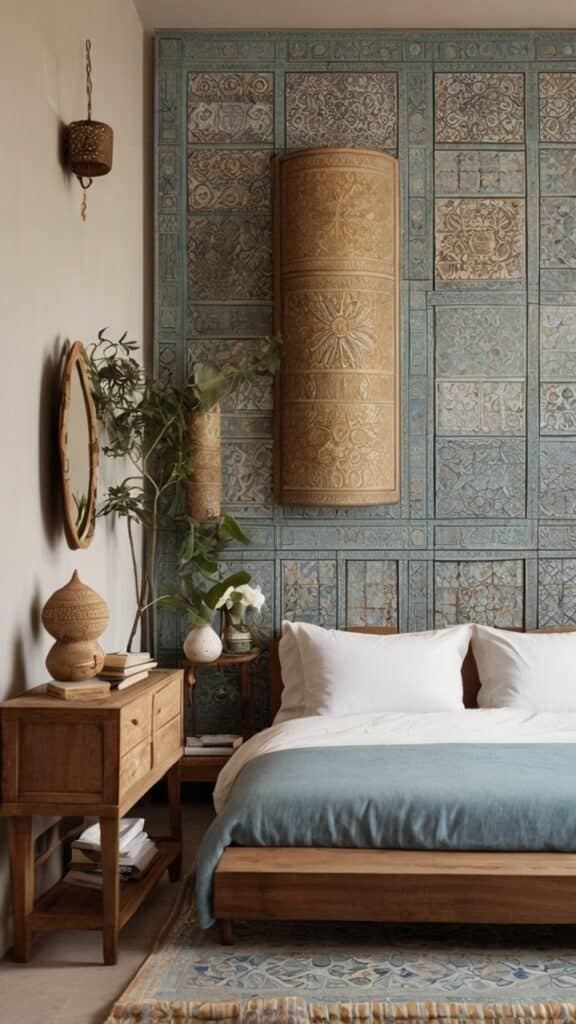
Zellige tiles – those glossy, hand-cut terracotta tiles arranged in intricate geometric patterns – are perhaps the most recognizable element of Moroccan design. While retiling an entire bedroom might be impractical, there are numerous ways to incorporate this distinctive look.
For 2025, we’re seeing creative applications like zellige-inspired tile headboards, vanity backsplashes in adjoining bathrooms, or even just small tiled side tables. The modern approach favors simplified color schemes – perhaps all white tiles with dark grout to emphasize the pattern, or a monochromatic blue palette that feels fresh and contemporary.
If permanent tile installation isn’t an option, consider peel-and-stick tile decals for a temporary transformation, or zellige-patterned textiles for your bedding. Even something as simple as framed tile samples can add that distinctive Moroccan touch to your walls. I’ve even seen people use zellige-pattern contact paper to transform plain furniture into statement pieces – super affordable and surprisingly effective!
8. Indoor Plants & Moroccan Planters

Moroccan design has always embraced the lushness of vegetation, influenced by the country’s stunning courtyard gardens. Bringing plants into your Moroccan-inspired bedroom creates that sense of oasis-like tranquility while improving air quality.
The 2025 approach pairs trailing plants like pothos or string of pearls with traditional Moroccan ceramic planters featuring intricate painted patterns or metalwork stands. Look for planters with that distinctive blue and white palette or terracotta with carved geometric details. The contrast of organic, flowing plants against structured, patterned containers creates visual tension that’s very satisfying.
Consider hanging plants from the ceiling in macramé holders (another nod to Moroccan textile traditions) or grouping several at different heights in a corner. Snake plants with their strong architectural shape are particuarly good choices for Moroccan-inspired spaces, as their rigid form echoes the geometric patterns found throughout the design style. Even just one statement plant in an authentic Moroccan planter can transform a bedside table or empty corner.
9. Canopy Beds & Draped Fabrics
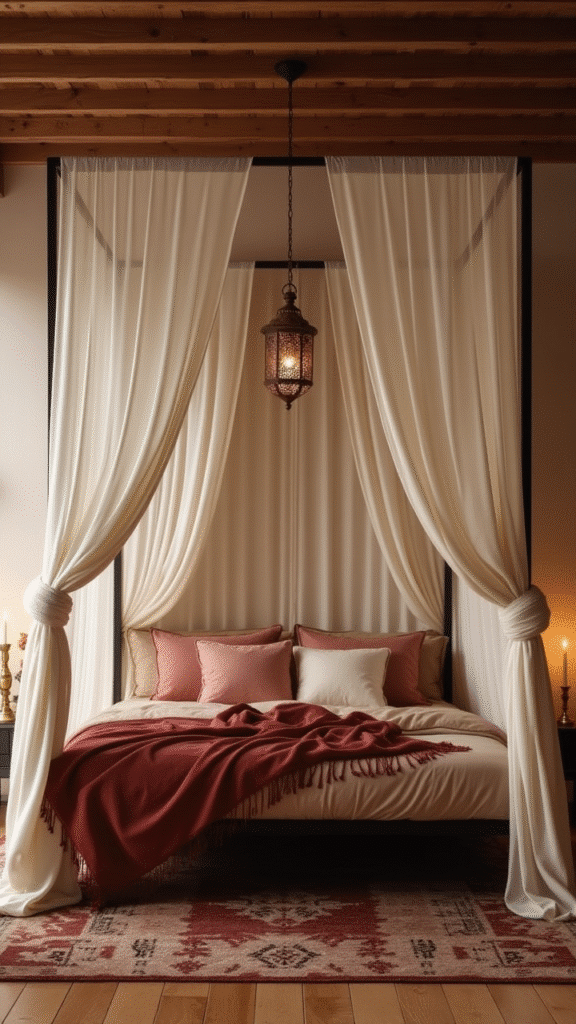
Few bedroom features capture the romantic essence of Moroccan design better than a canopy bed draped with flowing fabrics. This creates an intimate space-within-a-space feeling that’s both luxurious and cozy.
For 2025, we’re seeing modernized interpretations of this classic element. Contemporary canopy beds with clean, minimalist frames provide the structure, while sheer curtains in jewel tones or subtly patterned fabrics add that distinctly Moroccan softness. Some designers are using metal frames with Moroccan-inspired cutout patterns that cast beautiful shadows when backlit.
If you don’t want to invest in a new bed frame, create a DIY canopy by installing ceiling-mounted curtain rods or even repurposing decorative metal screens suspended above your existing bed. The draped fabric effect can be achieved with anything from actual curtains to lightweight scarves or even repurposed saris with metallic embroidery. The flowing textiles not only look beautiful but also add acoustic softness to the room, creating a quieter, more peaceful sleep environment.
10. Moroccan Wedding Blankets (Handira)
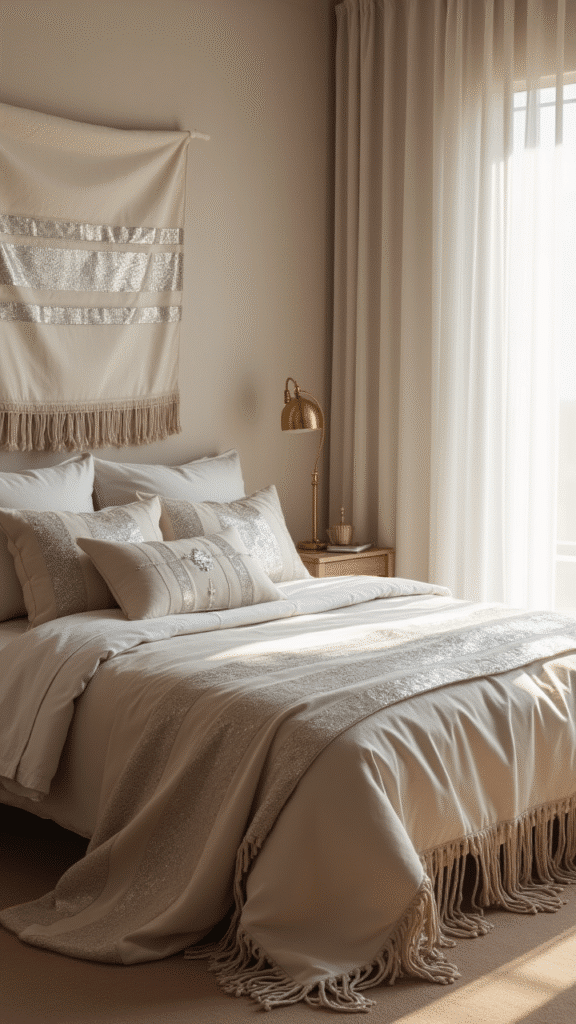
The traditional Moroccan wedding blanket, or Handira, has become a sought-after accessory for designers worldwide. These distinctive textiles, handwoven from wool and cotton and adorned with sequins and metallic embellishments, were traditionally given to brides for their wedding night.
In 2025’s bedroom trends, we’re seeing these special pieces used in various creative ways – draped across the foot of beds, hung as wall tapestries, or even repurposed as headboards. Their neutral palette (typically cream or white with metallic accents) makes them versatile enough to work with virtually any color scheme, while their texture and subtle sparkle add instant visual interest.
Authentic Handiras can be expensive, but the good news is that many artisans and companies now offer modern interpretations at various price points. Look for pieces that maintain the distinctive sequined or mirrored embellishments, which catch the light beautifully and add a touch of magic to your space. Even a small Handira-inspired throw pillow can introduce this special Moroccan element to your bedroom.
11. Filigree Mirrors & Reflective Surfaces
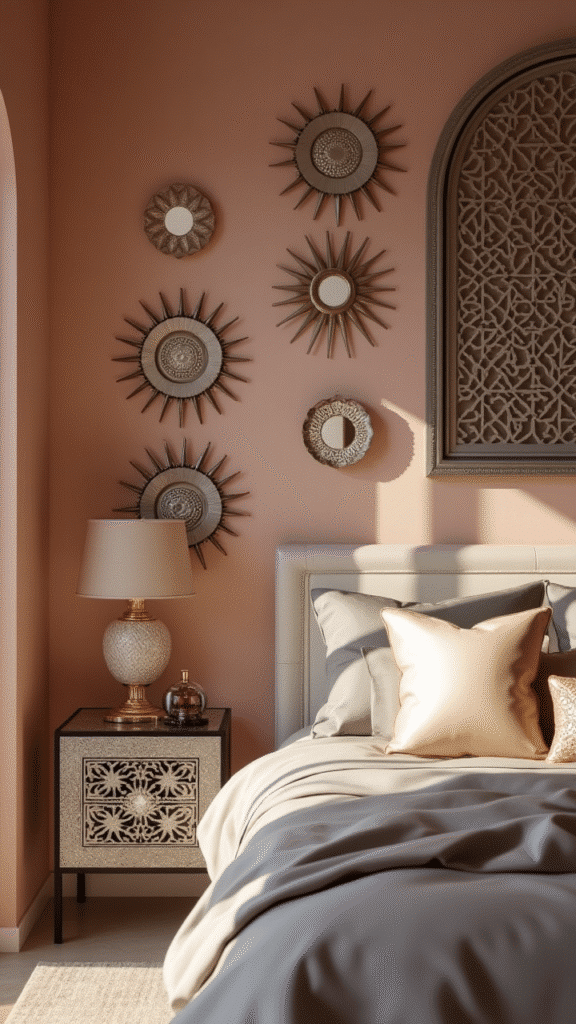
Mirrors have always played an important role in Moroccan interiors, used not just for function but as decorative elements that enhance light and create the illusion of space. The distinctive Moroccan mirror style features intricate metalwork frames, often in arched or star-shaped designs.
The 2025 approach to Moroccan mirrors favors oversized statement pieces or creative arrangements of smaller mirrors grouped together. Some designers are combining traditional filigree frames with modern mirror shapes for an updated look. These reflective surfaces serve the practical purpose of making bedrooms appear larger while also amplifying natural light.
Beyond traditional mirrors, consider incorporating other reflective surfaces like metallic side tables, brass trays, or accessories with mirrored inlay work. These elements catch and scatter light, creating that magical, glimmering quality that makes Moroccan spaces feel so special. Even something as simple as a collection of small mirrored tea light holders scattered across surfaces can create beautiful reflective moments throughout the room.
12. Modern Minimalist Moroccan
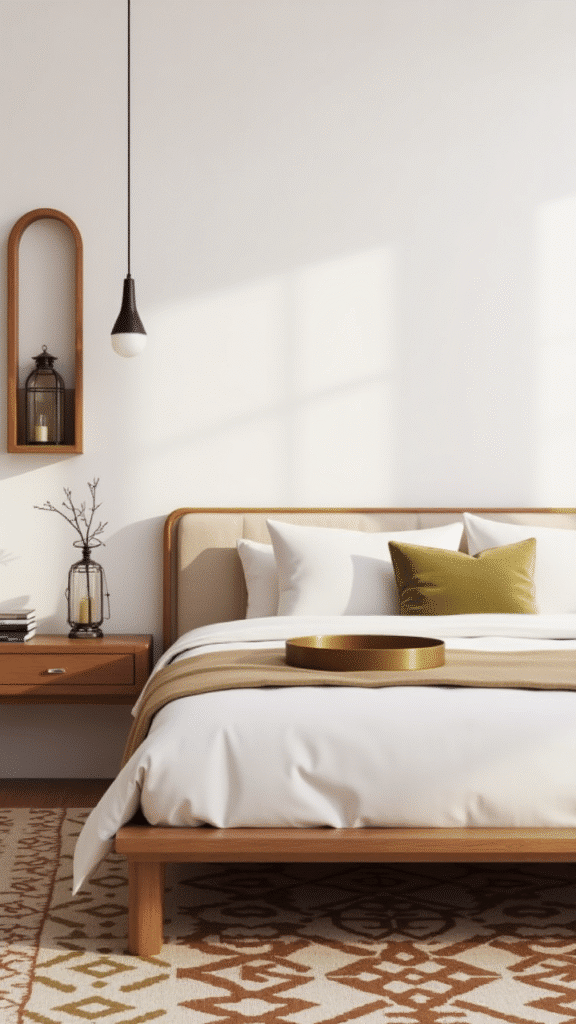
For those who love Moroccan elements but prefer a more restrained aesthetic, 2025 brings the trend of “Minimalist Moroccan” – a pared-back interpretation that focuses on clean lines and carefully curated statement pieces rather than abundant layering.
This approach might feature crisp white walls with just one or two large-scale Moroccan accessories – perhaps a stunning pendant light or an authentic rug. Furniture remains simple and contemporary, while architectural elements like arched doorways or niches provide subtle Moroccan character. The color palette typically sticks to neutrals with perhaps just one accent color used sparingly.
The beauty of this minimalist take is that it feels fresh and uncluttered while still capturing the essence of Moroccan design. It’s particularly effective in smaller bedrooms where too many elements might feel overwhelming. Think of it as Moroccan design distilled to its most essential and impactful components – proof that sometimes less really is more, even with a traditionally maximal design style.
13. Budget-Friendly DIY Moroccan Projects

Creating a Moroccan-inspired bedroom doesn’t have to drain your bank account. Some of the most authentic-looking Moroccan spaces I’ve seen incorporate clever DIY projects that capture the essence of the style without the hefty price tag.
Consider stenciling a Moroccan pattern on a plain wall to mimic the look of expensive tilework. Fabric stores often sell beautiful trims and tassels that can be added to plain curtains or pillowcases for an instant Moroccan update. Even simple tea glasses can be transformed into lanterns with some wire and a tea light. I’ve seen someone transform an ordinary IKEA dresser with overlay panels in Moroccan patterns – it looked like a custom piece!
Another budget-friendly approach is focusing on one investment piece – perhaps an authentic Moroccan rug or lantern – and building the rest of your decor around it with more affordable complementary items. This creates a focal point while allowing you to spread out additional purchases over time. Paint remains one of the most economical ways to transform a space – consider a deep jewel tone on just one wall to set the Moroccan mood without overwhelming your budget.
14. Indoor-Outdoor Connection
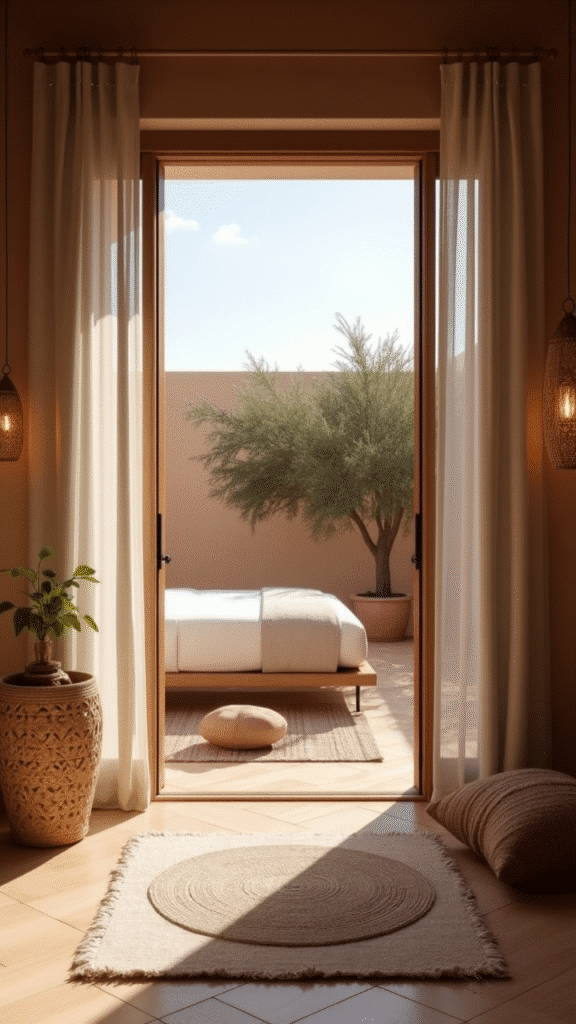
Traditional Moroccan homes often feature interior courtyards where the boundaries between indoors and outdoors blur. While recreating this architectural feature isn’t feasible for most bedrooms, you can capture the essence of this indoor-outdoor connection in other ways.
For 2025, designers are emphasizing bedroom connections to outdoor spaces wherever possible – positioning beds to face balconies or gardens, using sheer curtains that allow natural breezes, and incorporating natural materials throughout the space. If your bedroom has access to a balcony or patio, consider extending your Moroccan theme outdoors with floor cushions, lanterns, and potted citrus or olive trees.
Even without direct outdoor access, you can create this feeling through strategic use of plants, natural materials like wood and stone, and nature-inspired colors and patterns. Large-scale botanical prints that reference Moroccan garden plants can create a similar effect. Some homeowners are even installing small tabletop fountains to bring the gentle sound of water – a staple of Moroccan courtyards – into their bedroom sanctuaries.
15. Personal Heritage & Sustainable Sourcing
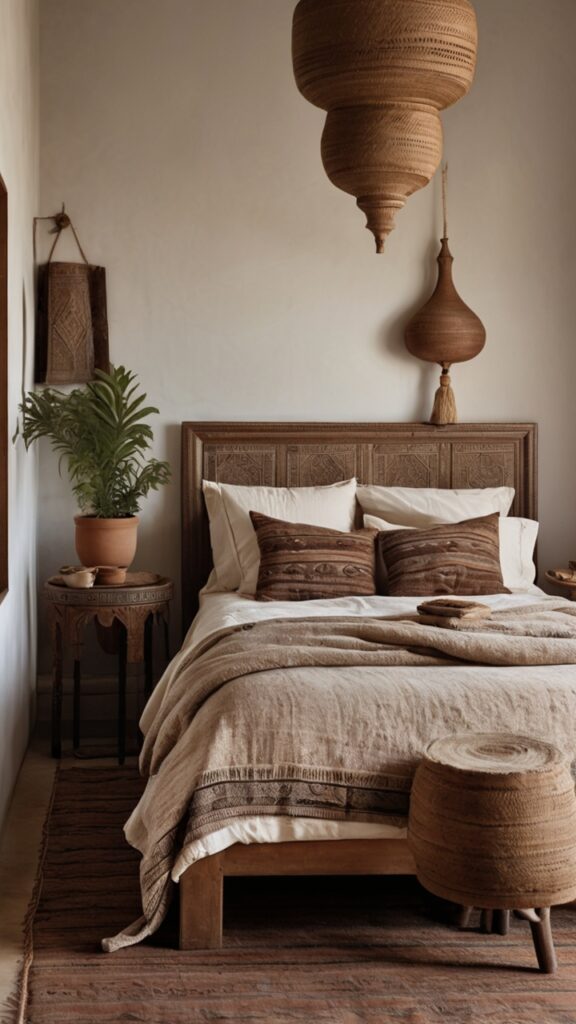
Perhaps the most important Moroccan bedroom trend for 2025 isn’t about specific design elements but about approach – specifically, a growing emphasis on authentic storytelling, sustainable sourcing, and supporting actual Moroccan artisans rather than mass-produced imitations.
More homeowners are seeking pieces with genuine provenance – items either purchased during travels, from fair trade cooperatives, or from companies that maintain ethical relationships with Moroccan craftspeople. This shift reflects a broader move away from disposable decor toward meaningful pieces that carry cultural significance and personal connection.
When creating your Moroccan-inspired bedroom, consider incorporating items that tell a story – perhaps a textile purchased directly from an artisan, a lantern from a specific region of Morocco, or even family heirlooms that connect to your own heritage. Mix these authentic pieces with contemporary elements to create a space that feels collected over time rather than purchased all at once from a catalog. This thoughtful curation results in a bedroom that’s not just beautiful but meaningful – a true reflection of both Moroccan design traditions and your own personal journey.
Bringing It All Together
Creating a Moroccan-inspired bedroom isn’t about following rigid rules or recreating a perfect replica of a riad in Marrakech. Instead, it’s about capturing the spirit of Moroccan design – its warmth, texture, pattern, and sense of handcrafted authenticity – and adapting those elements to suit your space, needs, and personal style.
The most successful Moroccan-inspired bedrooms feel collected rather than decorated, with a mix of old and new, high and low, pattern and solid that creates visual interest while maintaining harmony. Don’t be afraid to break convention – pair a traditional Moroccan wedding blanket with modern furniture, or place a sleek contemporary bed beneath an ornate metalwork pendant.
Ultimately, your bedroom should be a sanctuary that reflects you. The beauty of Moroccan design is its adaptability and its embrace of comfort, color, and personal expression. Whether you incorporate just one or two elements from this list or embrace the full Moroccan aesthetic, the result will be a bedroom that feels both timeless and distinctly your own – a perfect retreat for 2025 and beyond.

Mariana is the founder and voice behind Home Nookery, a curated blog dedicated to home design, décor inspiration, and cozy living. With a passion for creating beautiful, functional spaces, Mariana shares practical tips, styling ideas, and thoughtful insights to help readers turn their houses into homes. Whether you’re redesigning a room or just adding a touch of charm, she’s here to guide you with creativity and heart.
